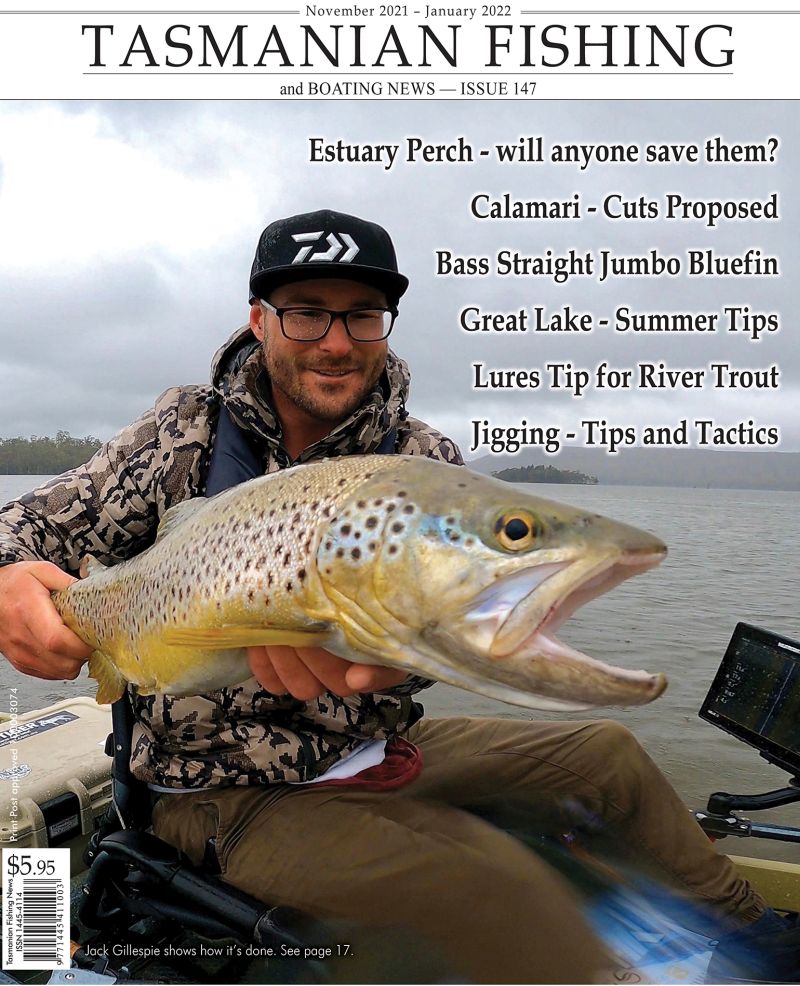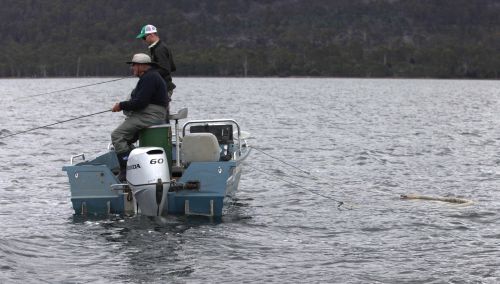From the Archives ...
Tiny creeks and sea run trout - Christopher Bassano
Presented from Issue 105, August 2013
Christopher Bassano fishes over 250 days a year. This interview was recorded just before he headed off to fish for Australia in the World Fly Fishing Championships in Norway 14-17 August 2013.
I live on a small stream and at the start of the season I like to go off on a bit of a discovery mission and fish the headwaters of the creeks and rivers I feel an affinity with.
These small rivers include the St Pats, Meander, Forester, Little Forester and others. The further up you go on these rivers the clearer and lower the levels. They are often less affected by the rain and runoff and you get some good opportunities. Get as close to the source as you can and you will find some good dry fly fishing. Don’t limit yourself to those I have mentioned. Most headwaters will hold trout.
Read more ...Please check all relevant authorities before fishing - www.ifs.tas.gov.au and dpipwe.tas.gov.au . Don't forget issuu.com/stevenspublishing for years of back issues !
Great Lake in Spring
Lets face it, Great Lake at first glance is not the most inviting of waters. Barren rocky shores and drawn down bays do little to invite the fisherman to try his hand. But this lake offers good sport right through the season for both the boat and shore angler alike. October and November see the onset of warmer weather as Spring pushes on. Midge start to hatch more regularly making morning wind lanes inviting, and the gum beetles and other terrestrials around the lake begin to offer the dry fly fisherman a taste of things to come. However around the shore there is some excellent wet fly fishing to be had, and this also boons during the late spring to early summer period.- Category: Great Lake
- Hits: 5930
Mega Multi Tool Review
Back in the old days everybody's Grandpa had a favourite pocketknife. Times change however and the pocketknife has been replaced by the multi-tool, a hybrid of the Swiss Army knife and the humble plier! Here is the latest and greatest in multi-tools for those thinking of a Christmas present, or just another toy.
- Category: Tackle, Boats and other Equipment
- Hits: 8003
Tidal Talk
Well we missed the tenth birthday of the Recreational Fishing Branch which was in June. So after 10 years in the harness I have decided to retire and do my bit to increase recreational fishing effort.
- Category: Saltwater and Estuary Fishing
- Hits: 4987
Tamar Bream
Southern black bream (Acanthopagrus butcheri) are one of Tasmania's great sport fish. They have the lot, great fighting, great eating and, on Tassie's North East and East coasts, they are in great numbers.
- Category: Tamar River
- Hits: 10698
Fishing Highlights, August to September Daniel Hackett
The majority of Tasmanian fishers think of themselves as a relatively tough bunch, "any harder they'd rust', battling relentless snow, rain and sun (somebody has to do it). Despite the obvious ruggedness of the fishers in question, the battle hardened Taswegian trouter is more likely to be found tucked up in bed eating Nan's chicken soup during August and September rather then on the water. This is a pity because any time is a good time to go fishing, and August and September are no exceptions. Pack away your blouses, pull on a beanie and try a few of these highlights!
- Category: Trout Fishing
- Hits: 6233
Read more: Fishing Highlights, August to September Daniel Hackett
Catching Dead Fish.
Lawrence Archibald Smith, better known as Larry to his mates and the constabulary, is a fish catcher of some renown. By fair means or foul Larry very rarely comes home without a feed. But even Larry out did himself the day he caught and landed a fish that had been dead for several hours.
- Category: Saltwater and Estuary Fishing
- Hits: 5301
Four Springs Lake
There is no doubt Tasmania hosts the best fly-fishing in Australia, our Central Highlands Lakes are world renowned. For those who live in the North of the State there is another piece of water which gives the opportunity of a trophy size brown or rainbow trout, Four Springs Lake.
Situated 16 kilometres North of Hagley via Selbourne Rd (C735), Four Springs holds both brown and rainbow trout that regularly exceed 6 pounds in weight.
- Category: Four Springs
- Hits: 9183
Chasing Calamary
A small fishery developed in Tasmania for southern calamary in the early 1980's, with annual landings of around 10-30 tonnes up until 1997/98. Catches have risen pretty quickly over the last few years, recently fluctuating around the 80-100 tonne mark and prompting several research projects into the biology of southern calamary. The Recreational Fishery Trust, DPIWE, Tasmanian Industry Fishing Council, individual commercial fishers, and the Australian Research Council, are all supporting an exciting new calamary tagging and hi-tech tracking project, based at the Tasmanian Aquaculture & Fisheries Institute. The project began in May this year and will run until April 2006, with most of the fieldwork conducted over the next two spring/summer spawning seasons.
- Category: Saltwater and Estuary Fishing
- Hits: 6847
Squid: the biology basics
Squid belong to a group of animals called cephalopods, which includes the octopus, cuttlefish, and nautilus. In Tasmanian waters, we have both the smallest squid in the world, the pygmy squid at a tiny 2cm, and the largest squid - the giant squid, with squid rings as big as truck tyres. From a biological perspective, squid are rather bizarre creatures. They have not one, but three hearts - one at the base of each of two gills to pump deoxygenated blood through the gills, and one main heart to pump oxygenated blood through the rest of the body.
- Category: Saltwater and Estuary Fishing
- Hits: 5971
Meander Valley Dam - Daniel Hackett
The proposed Meander Valley dam is one of many environmental issues currently facing Tasmanians. Despite its high profile there are still a lot of questions many Tasmanians have regarding the proposed dam and what it might create. In relation to fishing many of us ask will it be a new fishery, will it make or break the river, do we need another dam? On the 20th of May, Tasmanian Fishing and Boating News invited a number of stakeholder groups to submit their respective comments and/or opinions on the proposal. It was great to see the Department of Primary Industries, Water and Environment, the Tasmanian Greens and The Tasmanian Conservation Trust happy to provide their opinion for Tasmanian Fishing and Boating News readers.
- Category: Meander River
- Hits: 7386
Subcategories
Current TFBN
Click above for current issue content. The current issue of TFBN is extensive and topical. In Tackle Stores, Newsagents and by subscription.
Delivered to your door for $48 for 2 years (8 issues). To subscribe, send Mike $48 via www.paypal.com.au . (Basic instructions are here) The email is at Contact Us. Your address will be included from PayPal.
Or phone Mike with your c/c handy on 0418129949
Please ensure your details are correct, for Mike to organise delivery.
TFBN Newsletter Sign up Form
Why not submit an article ?
When you have finished for the day, why not have a brag about the ones that didn't get away! Send Mike an article on your fishing (Click here for contact details), and we'll get it published here. Have fun fishing - tasfish.com
Category Descriptions
Here is a list of all of the Article Categories. The number in Brackets, eg (13) is the number of articles. Click on Derwent River and all articles relating to the Derwent will be displayed in the central area.
Articles by Category
-
Rivers (3)
-
Saltwater and Estuary Fishing (149)
-
Kayak Fishing (34)
-
Lakes (1)
-
Great Lake (62)
-
Lake Leake (52)
-
Woods Lake (16)
-
Lake Augusta (11)
-
Huntsman Lake (13)
-
Lake Pedder and Gordon (10)
-
Lake Dulverton (5)
-
Lake Crescent (6)
-
Tooms Lake (10)
-
Lake Mackintosh (2)
-
Lake Barrington (5)
-
Little Lake (8)
-
Meadowbank Lake (5)
-
Lake King William (7)
-
Lake St Clair (2)
-
Western Lakes (12)
-
Arthurs Lake (35)
-
Lake Echo (7)
-
Four Springs (54)
-
Lake Sorell (7)
-
Lake Burbury (6)
-
Other Lakes (57)
-
Brushy Lagoon (18)
-
Little Pine Lagoon (5)
-
Penstock Lagoon (16)
-
Brumbys Creek (7)
-
-
Events (48)
-
Estuary Fishing (0)
-
Coastal Catches (46)
-
Super Trawler (46)
-
IFS, DPIPWE, MAST and Peak Bodies (435)
-
Commercial Interests (98)
-
Other (24)
-
TFBN Back Issues (8)
-
Fly Fishing (67)
-
Trout Fishing (252)
-
Meteorology and Weather (8)
-
Jan’s Flies (50)
-
Tuna Fishing and other Game Fishing (86)
-
Cooking Fish (19)
-
Fishing Information (1)
-
Fishing Books (8)
-
Videos (5)
-
Tackle, Boats and other Equipment (146)
-
World Fly Fishing Championship 2019 (2)
Popular Tags
windyty.com
Visit https://www.windyty.com/
Rubicon Web and Technology Training
Hello everyone, I thought it would be a good time to introduce myself.
My name is Stephen Smith and I have been managing the website tasfish.com since May 2009.
It has been an epic journey of learning and discovery and I am indebted to Mike Stevens for his help, support and patience.
I am developing a new venture Rubicon Web and Technology Training ( www.rwtt.com.au ). The focus is two part, to develop websites for individuals and small business and to train people to effectively use technology in their everyday lives.
Please contact me via www.rwtt.com.au/contact-me/ for further information - Stephen Smith.
From the Archives ... (last chance)
Atlantic salmon the hard way
Atlantic salmon the hard way
Scott McDonald
The first Atlantic salmon eggs used to begin Tasmania's Atlantic salmon aquaculture industry were introduced into Tasmania in 1984. From these humble beginnings a valuable Tasmanian industry has evolved with a worldwide reputation for having a premium disease free product. This industry provides a spin off to all anglers in the form of regular escapes of salmon from the farms.



